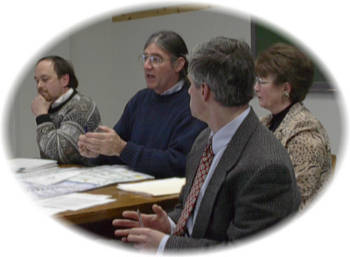
Wednesday, March 5, 2003
Sierra Club of Canada rejects JAG clean up options:
Full environmental review panel needed

Pictured (L to R):Doug MacKinlay, Bruno Marcocchio, Daniel Green, Neila MacQueen
(Sydney)—-The Sierra Club of Canada reacted with disappointment today to the proposed remediation options for the clean up of the Sysco property in Sydney, Nova Scotia, brought forward February 24 by CBCL, consultants for the JAG process. After taking time to have a technical review of the CBCL proposals, Sierra Club of Canadaís local members and national organization found the CBCL approach unacceptable.
“A seven-year process has resulted in options that are ineffective and unsafe. The promised safe, effective, socially responsible alternatives have been ignored in favour of dangerous unacceptable solutions the community has already rejected,” was the organizationís conclusion.
The group criticized the plan for failing to establish buffer zones to protect human health. *Dangerous and volatile PAHís, like benzene, naphthalene and xylene, will affect surrounding communities during dredging of the ponds.
* Should read "Dangerous and volatile chemicals..."
Neila MacQueen, Dorchester Street resident, lives less than 200 meters from the tar ponds. Despite unacceptable levels of heavy metals in her basement, no remediation has been offered. “When they stir up that material the fumes will make my home unbearable. It just seems that the health of north end residents just doesnít matter,” she said. “Why canít they offer residents like me who already have breathing problems a choice of leaving? Pretending that the danger will end at the fence is cruel and unacceptable.”
The JAG process was envisioned as a transparent, open process, where residents could take part in finding solutions for Canadaís worst hazardous waste site. As the transparency and openness disappeared and consultants to government behind closed doors proposed decisions, the Sierra Club of Canada and many dedicated residents abandoned the process. “The glossy brochure entitled Cleaning Up Our Site, outlining the options is an insult to all Cape Bretoners,” said Sydney resident Kenzie MacNeil. “Why has this suddenly become our site? The people here didnít create this problem nor should they be responsible for its clean up. It seems the only input we have is to take ownership of the problem that we had nothing do with creating. Variations of burn and bury options after seven years of backroom deliberations are not adequate”
The workbook that JAG is asking residents to fill out is not adequate public consultation. All ten options presented will allow the proponent to claim the community agreed with incineration proposals, either onsite or offsite or both. Nine of the ten options will legitimize the construction of a hazardous landfill at the coke ovens site. “This is not adequate public consultation” Elizabeth May, Executive Director of the Sierra Club Of Canada, stated. “We want the federal government to initiate a full panel review under section 28 of the Canadian Environmental Assessment Act. This community is already at risk and has significant concerns about health impacts. Public hearings that look at safer alternatives should be initiated immediately.”
Daniel Green, Sierra Club Scientific Advisor, has serious concerns about the scope of the remediation as proposed. “Sydney toxic contamination problems are not just limited to the Tar Ponds and Coke Oven sites. There were also tons of toxic emissions from the now closed coke ovens and the steel mill that have fallen on the community, “ Green said. “It is pure folly to think that the toxic fallout stopped at the gates of the plants. There are bound to be lasting human health effects from this contamination and it must be addressed, “ Green cautioned.
A paper published recently by Edward Furimsky in Environmental Management Journal entitled Sydney Tar Ponds: Some Problems in Quantifying Toxic Waste outlines these concerns:
Referring to the contaminated site as the Sydney Tar Ponds may be misleading because the site contamination by toxic metal-containing particulates is a more serious contributor. The lack of data on the hazardous and toxic nature of the waste on the Sysco plant site and surrounding area prevents an accurate estimate of the total amount of waste necessary for selecting appropriate cleanup methods and determining the overall cost. The rationale used in this study suggests that the amount of waste to be cleaned exceeds the reported amount (700,000 tons) by many times. It is essential that an extensive program involving an analysis of samples taken from the surface and various depths in the Sysco plant and surrounding areas be undertaken to establish an inventory of hazardous and toxic waste. Only with such a database can a reasonable conclusion on the final fate of the site be reached. The limited information that is available suggests that accurate mapping and/or inventorying of the waste at the Sydney Sysco plant is only in the early stages.
Without adequate testing of the soil and water in the surrounding community it is not possible to select an appropriate remediation technology. “We have made these tragic and wasteful mistakes in previous failed attempts to clean up the waste,” Bruno Marcocchio, Atlantic Conservation Director Sierra Club of Canada said. “Let us not waste this opportunity to clean up our community and protect the health of our children.”
– 30 –
For more information:
Bruno Marcocchio
Sierra Club of Canada Cape Breton Group, 902-539-3957
|

